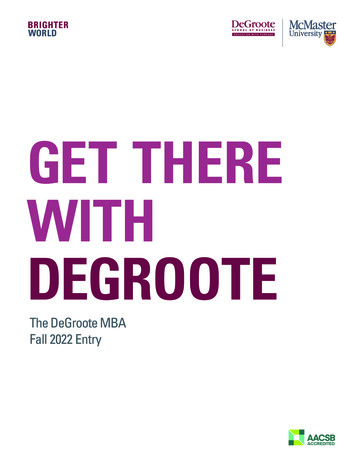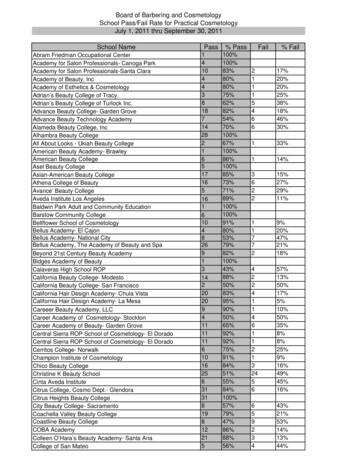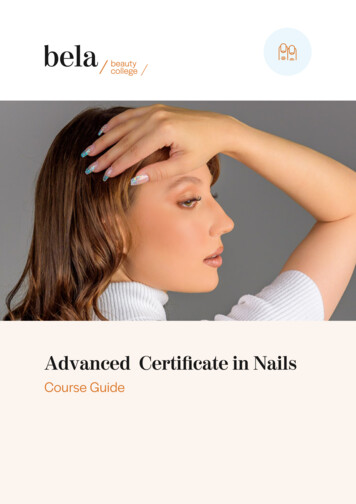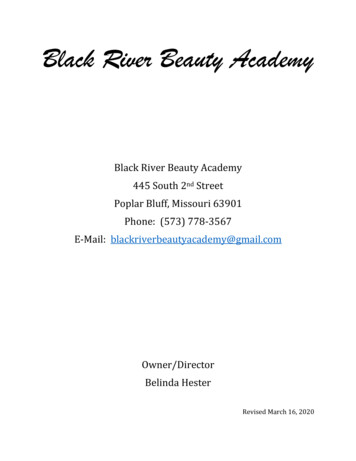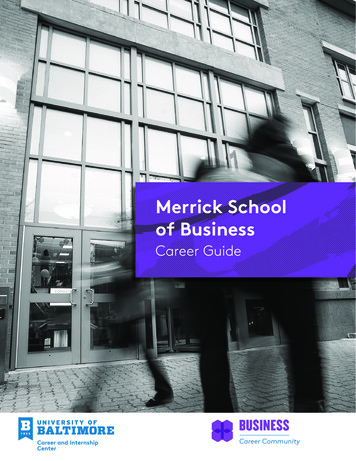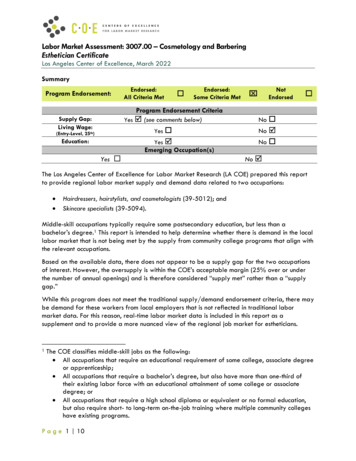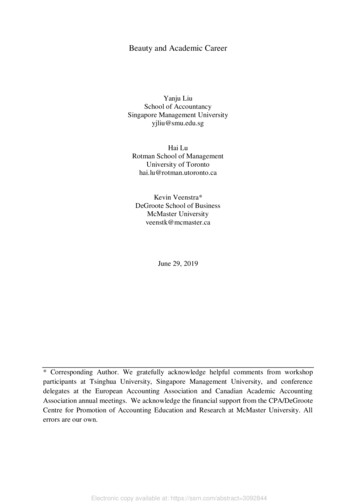
Transcription
Beauty and Academic CareerYanju LiuSchool of AccountancySingapore Management Universityyjliu@smu.edu.sgHai LuRotman School of ManagementUniversity of Torontohai.lu@rotman.utoronto.caKevin Veenstra*DeGroote School of BusinessMcMaster Universityveenstk@mcmaster.caJune 29, 2019* Corresponding Author. We gratefully acknowledge helpful comments from workshopparticipants at Tsinghua University, Singapore Management University, and conferencedelegates at the European Accounting Association and Canadian Academic AccountingAssociation annual meetings. We acknowledge the financial support from the CPA/DeGrooteCentre for Promotion of Accounting Education and Research at McMaster University. Allerrors are our own.Electronic copy available at: https://ssrn.com/abstract 3092844
Beauty and Academic CareerABSTRACTWe examine the impact of beauty on the academic career success of tenure-track accountingprofessors at top business schools in America, and show that beauty plays a significant role.Specifically, after controlling for gender, ethnicity, publication history, work experience, andquality of alma mater, more attractive professors obtain better first school placements postPhD and are granted tenure in a shorter period of time. These findings are broadly consistentwith behavioural theory which predicts that facial attractiveness irrationally affects theperception of performance characteristics. Interestingly, there is no incremental benefit ofattractiveness for the career progression from associate to full professor. This finding isconsistent with the notion that the role played by beauty in promotion diminishes when theindividual’s ability and competency become apparent over time.Keywords: Beauty, accounting, career, labor market.Electronic copy available at: https://ssrn.com/abstract 3092844
Beauty and Academic CareerI. INTRODUCTIONThe value of beauty and its capacity for generating positive evaluations and impressions haslong been the subject of discussion. A rapidly increasing body of literature in economics andsociology documents that beauty generates positive evaluations and impressions. In comparisonwith the less attractive, individuals with good looks are better liked (Walster, Aronson, Abrahamsand Rottman, 1966; Kleck and Rubinstein, 1975; Feingold, 1990) and receive more favourabletreatment in hiring, performance rating and promotion decisions (Landy and Sigall, 1974; Dipboye,Arvey and Terpstra, 1977; Landy and Sigall, 1974). Studies in the fields of economics andmanagement have explored the effect of beauty on business success and document an associationwith favorable traits of firms’ top management (e.g., CEOs), such as confidence (Mobius andRoensblat, 2006) and happiness (Hamermesh and Abrevaya, 2013), which in turn contribute tohigher shareholder values1. This widespread preference for physical attractiveness is commonlyknown as the “beauty premium” (Hamermesh and Biddle, 1994), and its potency is such that thateven those who associate with beautiful persons gain in perceived stature (Sigall and Landy, 1973).As previous studies have shown, the beauty premium exists in many social contexts and acrossa wide variety of professions, leading us to question whether it is caused by discriminatory orperceived valuable skills. On the one hand, physical attractiveness affects people’s perceptions ofintellectual competence and general mental health (Eagly et al., 1991; Feingold, 1992; Langlois et1For example, Halford and Hsu (2014) document that firms enjoy higher returns around their announcement of hiringmore attractive CEOs and higher acquirer returns upon acquisition announcements.1Electronic copy available at: https://ssrn.com/abstract 3092844
al., 2000; and Hosoda et al., 2003). Beautiful individuals are considered more socially competent(Miller, 1970; Dion, Berscheid and Walster, 1972; Eagly, Ashmore, Makhijani and Longo, 1991).On the other hand, the literature also shows the link between beauty and positive life outcomes tobe largely discriminatory and driven by the favorable treatment from others (Dion, Berscheid andWalster, 1972; Hamermesh and Biddle, 1994; Mobius and Rosenblat, 2006). Given the mixedevidence, what drives the beauty premium remains a controversial issue.It is this debate that motivates us to re-examine the question in a new, previously unstudied,setting. In this paper, we explore whether and how the beauty premium exists in academic careerprogression. Specifically, we examine whether beauty is associated with the quality of the firstplacement, the time to tenure, and the time from associate to full professor. There are severalreasons to care about answers to this question. First, the vast majority of existing labor marketbased beauty research is cross-sectional, focusing on the impact of beauty at a specific point intime. Little is known about the impact of beauty over the course of a person’s career. 2 In this study,we extend the prior literature by assessing the impact of beauty on a professor’s career progression.Second, compared to industry jobs, performance evaluation criteria on research and teaching inacademia are relatively clear and objective, making the hiring and promotion decisions lessvulnerable to behavioral biases. If a “beauty premium” persists, this suggests that either academiais not as “fair” as we expect or the “perceived valuable skills” explanation dominates. Third, fromthe perspective of PhD students and junior faculty members, while it is difficult to change their2One notable exception is that of Sala et al. (2013), who use the Wisconsin Longitudinal Study data to assess theimpact of facial attractiveness on people’s socio-economic standing over one’s life. The authors find that attractivenessmatters for both genders and that its impact on occupational prestige is as important at the beginning of one’s careeras it is at the end of one’s career, with no cumulative effects over one’s working career.2Electronic copy available at: https://ssrn.com/abstract 3092844
looks, understanding whether the bias exists and where it comes from can help them act to mitigateor avoid such biases.We select accounting professors in US research institutions for this study, for several reasons.First, all PhD accounting programs in the US have a very clear mission of placing students toacademic institutions. For this reason, each school only admits a few PhD students per year (i.e.,usually between 2 to 4) and upon graduation, almost all accounting PhDs are placed at postsecondary educational institutions.3 This placement strategy differs markedly from PhD programsin science, engineering, and economics, where most graduates find jobs in industry, and mitigatesthe self-selection concern that the physical appearance of industry orientated PhD graduates differssystematically from those who remain in academia. Second, accounting is a well-structureddiscipline in business schools. Since teaching performance and research productivity are relativelyeasy to measure, the quality and quantity of research can be controlled more effectively. Finally,the relevant study and work experience of this paper’s authors allows us a better understanding ofthe nuances involved in the hiring and promotion process.We expect a positive association between beauty and indicators of academic success. Anacademic career is a long journey. The quality of the first placement, the smooth process to tenure,and the time it takes to be promoted to full professor all suggest success at different stages of one’scareer. However, a candidate’s intellectual and social competencies are not readily apparent withina short time period. At the time of graduation, most newly minted PhDs do not yet have a top tier3While our main sample only consists of those individuals who are in tenure track positions as of 2015, in supplementalanalysis we extend our sample to include all individuals who graduate with a PhD from a top 50 US business schoolduring the years 1974 to 2016. It consists of 1,376 additional PhD graduates placed at schools of varying quality. Veryfew individuals leave academia. Only 1.3% of these graduates go straight to industry or to lecturer positions aftercompleting their PhD studies. We collect the information from annual Hasselback Accounting Faculty Directories.3Electronic copy available at: https://ssrn.com/abstract 3092844
publication and much of their work has been under supervision of, or co-authored with, others. Assuch, typical signals, such as the supervisor’s recommendation letter and the list ofpublications/working papers, could be very noisy proxies of one’s research ability and may drivehiring committees, consciously or unconsciously, to factor in attractiveness as a proxy for ability,resulting in more attractive candidates being placed at higher quality schools.We download the photos and CVs of accounting faculty members from university websites forthe Businessweek Top 50 2015 MBA School rankings, and the top 50 2015 Brigham YoungUniversity’s (BYU) Research Publication rankings. We then supplement this list with accountingfaculty from 31 lower tier US business schools, bringing our complete sample to 93 US businessschools 4 yielding a total of 714 photo/CV combinations, from which we extract informationconcerning the variables we need to control for. These variables include education background,employment history, and information about publications and teaching. For each photo, we takeadvantage of M-Turk, an Internet sourced study participant pool run by Amazon.com, to rate photoattractiveness. Each photo is rated, on average, by 25 MTurk workers.We first examine the association between beauty and the school ranking of a PhD candidate’sfirst job placement. The school’s ranking is based on i) Businessweek Top 50 MBA School rankingsfor 2015; or ii) Brigham Young University’s (BYU) Research Publication rankings for 2015. Aftercontrolling for a number of personal characteristics and academic pedigree, we find a strongpositive impact of perceived attractiveness on the school ranking of a PhD candidate’s first job4These lower tier institutions include the schools that some faculty have ultimately moved to such as AuburnUniversity, Case Western Reserve University, Miami University, Saint Louis University, and University of Tennessee.There are a number of Businessweek and BYU universities for which photos and CVs could not be obtained. Theseexceptions include South Carolina and Thunderbird for Businessweek rankings, and Temple, Florida International,Pittsburgh, Rutgers, Arkansas, and South Carolina for BYU rankings.4Electronic copy available at: https://ssrn.com/abstract 3092844
placement. In other words, more attractive PhD candidates are placed to more highly rankedschools. Mediation analysis reveals that approximately 39% of the relationship between beautyand first placement quality is mediated by the number of flyouts a PhD candidate receives whileon the job market. These findings show that while part of the relationship between beauty and labormarket outcomes may be justified, the majority of the benefits accruing to beautiful individuals arediscriminatory in nature.Next, we examine the association between beauty and time to tenure. Because tenure is notalways achieved in one’s first placement school, individuals are forced to move if they fail to meetthe tenure requirement of their current schools after the tenure clock runs out. Meanwhile, it islikely that some individuals voluntarily move to other schools if competing schools are exploitingthe uncertainty of the tenure process and lure away good researchers. Therefore, when examiningthe association between beauty and time to tenure, we consider three scenarios: i) when tenure isachieved at a professor’s first school placement; ii) when tenure is achieved at a professor’s secondschool placement when there is a voluntary early departure from the first school; and iii) whentenure is achieved at a professor’s second or subsequent school placement and leaving the firstschool is a forced decision. We find that for scenarios i) and ii), there is a negative associationbetween beauty and time to tenure. In other words, it takes less time for more attractive professorsto achieve tenure. However, for scenario iii), we find that the time to tenure is not affected by theirperceived attractiveness. We further conduct mediation analysis and find that the number of uniquecoauthors on all published papers, the number of workshop presentations and the number ofcitations partially mediate the relationship between beauty and time to tenure. The majority of thebenefits still accrue to the direct beauty-time to tenure relationship.5Electronic copy available at: https://ssrn.com/abstract 3092844
Further, we examine the association between beauty and the time to full professorship. Similarto the results for those professors who obtain tenure at their second or subsequent school, we findthat the time to full professorship is not affected by beauty. These findings are consistent with thenotion that sufficient time has passed for these individuals to demonstrate their ability. Physicalattractiveness is no longer a behavioral bias.Our study contributes to economics and psychology literature in several ways. First, throughstudying the direct impact of attractiveness on career success in academia, we address the questionwhether the beauty premium is due to behavioral bias or perceived valuable skills. No publishedstudy to date has explored the impact of physical attractiveness on initial job placement and careerprogression in tenure-track research positions.5 We are the first to show that when job candidatesare seeking their first position as an assistant professor, hiring committees and tenure andpromotion committees rely on attractiveness as a proxy for expected future potential. We are alsoamong the first researchers to explore the differential impact of beauty over the course of a person’scareer. Early in the academic’s career, the beauty premium is “alive and well”. However, as theircareer progresses, the beauty premium disappears and is not a determinant of the promotion fromassociate to full rank professor. Remarkably, the market does not seem to correct for the patternover time, as the same pattern observed for those professors obtaining tenure and full professorship5Sullivan and Dubnicki (2012) explore the determinants of the quality of first placement based on 849 economics PhDgraduates in 2011. The working paper appears to be related to our study, but there are significant differences betweenthe two. Only 50.5% of the PhD graduates in Sullivan and Dubnicki’s sample are placed in economics departments.For non-academic placements, rankings are assigned arbitrarily. For example, placement to a business school equalsthe placement university's economics department ranking plus five; non-tenure track job or postdoctoral positionequals the placement university’s economics department ranking plus 15; World Bank, International Monetary Fund,and Federal Reserve Board (6.4% placements) are equivalent to the 40th best economics department. The sample alsoconsists of 31.9% non-US placements. With all this noise, they find some evidence that attractive, white, femalecandidates place at better institutions.6Electronic copy available at: https://ssrn.com/abstract 3092844
in the 1980s and 1990s continues to be seen for those professors being promoted more recently inthe 2000s.Second, we take advantage of this unique setting to investigate the differential impact ofperceived competency and perceived trustworthiness, in addition to perceived beauty, on careersuccess. Recent papers have found that perceived competency or trustworthiness predict somecareer outcomes better than perceived beauty. For example, Dilger et al. (2015) find that researchperformance is not influenced by attractiveness but especially by perceived trustworthiness. Asanother example, Graham et al. (2017) find that competent looks, but not attractiveness ortrustworthiness, are reflected in CEO compensation. CEOs have a long history to reveal their talentbefore their hiring, which is different from our setting. We find that attractiveness subsumes theimpact of perceived competency and trustworthiness in all career outcomes 6. Our findings areconsistent with the notion that the “halo effect” relates to attractiveness, not to competency ortrustworthiness.Third, we take advantage of the progress in technology to improve our methodology. Only ahandful of large-scale surveys have collected independent evaluations of physical attractiveness(Sala et al., 2013). Most rely on a single rating of a respondent’s attractiveness either by theinterviewer, the respondent, or a teacher. We add a new level of rigor to the literature, gaining moreobjective ratings of respondents’ attractiveness by using photographs and having them rated, onaverage, by 25 unrelated individuals. This treatment is expected to reduce measurement noisesignificantly.6The relationship between beauty and perceived competency/trustworthiness is relatively strong, with correlationsbetween 0.4 and 0.5 for all samples.7Electronic copy available at: https://ssrn.com/abstract 3092844
Fourth, our findings have important practical implications. While only a very small percentageof the population become tenure-track professors at America’s business schools, a large percentageof the population is educated by these individuals. As such, prospective students would do well toknow the differential impact of attractiveness in the selection and promotion of professors asattractive professors may not necessarily be better researchers and educators. Senior faculty shouldkeep this in mind the next time they hire a rookie PhD or decide whether or not to grant tenure toan assistant professor. Aspiring PhD candidates should note that while they may have little abilityto change their attractiveness, it may have a significant influence on their career progression. Whilethe benefits of beauty disappear in the latter stages of one’s career, this may be “too little, too late”for less attractive professors as the benefit of obtaining an initial job placement at a top rankedschool has long lasting effects.The remainder of this paper is organized as follows. Section 2 discusses the related literatureand develops the hypotheses. Section 3 describes data and research design. Section 4 presents theresults of the empirical analysis. Section 5 concludes.II. LITERATURE REVIEW AND HYPOTHESES DEVELOPMENT2.1 Background and Related LiteratureBroadly speaking, there are two general perspectives on the observed relationship betweenattractiveness and success. These perspectives are: i) neoclassical - attractive individuals are“better” than their less attractive peers (i.e. smarter, socially competent); and ii) behavioral attractive individuals are no “better” than others and succeed due to discrimination on the part ofsociety (Graham et al., 2017).As an example of support for the first perspective, the empirical findings of Kanazawa andKovar (2004) led them to reason that beautiful people are more intelligent when the following four8Electronic copy available at: https://ssrn.com/abstract 3092844
conditions are present: 1) more intelligent men are more likely to attain higher status; 2) higherstatus men are more likely to mate with more beautiful women; 3) intelligence is heritable and 4)beauty is heritable. Large nationally representative samples from both the United Kingdom and theUnited States supply Kanazawa (2011) with additional evidence that attractiveness and generalintelligence are positively associated. Mocan and Tekin (2010) find that unattractive individualshave a higher proclivity for committing crime. The authors suggest beauty may positively impacthuman capital formation since attractive individuals participate in more activities that buildconfidence and leadership skills. These skills, in turn, can lead to increased success in the labormarket. Conversely, for unattractive individuals lack of human capital formation can lead to anincreased likelihood of school suspension and a lower grade point average. Further support can befound in Feingold’s (1992) meta-analysis of the literature, where social skills, freedom from socialanxiety, opposite-sex popularity, and sexual experience are correlated with independent ratings ofphysical attractiveness (e.g. Lerner and Lerner, 1977; Pilkonis, 1977). More recently, in anexperimental labor market where employers determine the wages of workers performing a mazesolving task, Mobius and Rosenblat (2006) find that 15% to 20% of the beauty premium istransmitted through higher self-confidence.In terms of the second perspective, Dion (1973) finds that preschoolers discriminate differencesin facial attractiveness, showing a distinct preference for attractive over unattractive children aspotential friends. In another study by Clifford and Walster (1973), randomly selected fifth gradeteachers evaluate a child’s potential based only on the child’s report cards and his/her photograph.The results confirm the researchers’ expectation that physical attractiveness affects teachers’judgements in rating children’s social potential and intelligence. Benson, Karabenick and Lerner(1976) make use of a novel research setting in which hundreds of graduate school applications are9Electronic copy available at: https://ssrn.com/abstract 3092844
left in public phone booths in a large metropolitan airport. The applications only differed in thephotograph of the applicant attached to the application. As predicted, delivery of the applicationwas facilitated more for attractive than unattractive persons.Turning to academia, a few studies have explored the beauty effect in the classroom. Amongthem, Hamermesh and Parker (2005) find that moving from one standard deviation below to onestandard deviation above the mean instructor attractiveness level is associated with a one standarddeviation increase in the average class effectiveness rating. Consistent with this finding, Rosen(2018) finds a positive relationship between instructor quality and attractiveness.Other studies find similar results in work settings. For example, Landry et al. (2006) investigatethe influence of attractiveness in the context of several charitable fund-raising strategies, findinghigher attractiveness of female solicitors is associated with both increased contributions andparticipation.Most recently, Ruffle and Shtudiner (2015) investigate the role of physicalattractiveness in the hiring process. They send over 5000 CVs, in pairs, to approximately 2600advertised job openings. For each pair, one CV is without a photo whereas the other one includesa picture of either an attractive or a plain-looking individual. Employer callbacks to attractive menare significantly higher than to plain-looking men and to men with no photos. Surprisingly, perhapsdue to jealousy, attractive women did not enjoy the same beauty premium.Overall, the findings provide consistent evidence that many benefits afforded to attractiveindividuals are discriminatory in nature, supporting the second perspective primarily and the firstperspective to a lesser degree. Our brains seem genetically predisposed to subconsciously form anattractiveness stereotype, associating beauty with positive attributes.This phenomenon iscommonly known as the “beautiful-is-good” halo effect of attractiveness (e.g. Miller, 1970; Dion,Berscheid and Walster, 1972; Langlois, 1986; Eagly et al. 1991; Feingold, 1992; Jackson et al,10Electronic copy available at: https://ssrn.com/abstract 3092844
1995). While a number of theories provide slightly different explanations for this discrimination,they are all broadly consistent with systematic biases of the mind (Kahneman, 2011).2.2 Hypotheses DevelopmentHumans are fundamentally social beings (Baumeister and Leary, 1995). We try to preservethe integrity of our social group and status when selecting new group members. Consider theimpact of our evolutionary past on the inner workings of the brain, where many social interactionswere brief and provided limited information. The same can be said of many social interactions weencounter in today’s modern world. Not surprisingly, then, we often rely on first impressions toselect new group members (Todorov et al., 2005; Bar, Neta and Linz, 2006; Willis and Todorov,2006).7At the time of completing a PhD, most graduates do not yet have a top tier publication and theirwork may be heavily influenced by mentors and senior co-authors. Recommendation letters fromthe graduate’s thesis supervisory committee are typically favorably biased, making it difficult forprospective employers to assess a candidate’s true potential.A significant component in the hiring process is the campus visit, where candidates presenttheir thesis paper and meet individually with faculty members. A large part of the interviewexperience is “visual”, much like that of a presidential candidate performing on television, and this7A famous example that highlights the rise in importance of appearance was the first presidential debate betweenRichard Nixon and John F. Kennedy. Following the presidential debates, radio polls favored Nixon while televisionpolls predicted that Kennedy would win. Ultimately, Kennedy won the presidency with many pundits attributing thewin to Kennedy’s superior image on television; as Kennedy was not better than Nixon on the actual issues. Druckman(2003), in a controlled experiment, confirmed these claims using the original historical files and his students aslisteners/viewers. While radio listeners were the only participants in his study to consider issue agreement whenassessing leadership effectiveness, television viewers were the only participants to consider perceptions of integritywhen evaluating these same candidates.11Electronic copy available at: https://ssrn.com/abstract 3092844
is where attractive individuals excel. In their experimental setting using undergraduate studentsand local townspeople, Mulford et al. (1998) find that attractive individuals are advantaged in twoways; first, they have greater opportunity for social exchange; and second, these exchangeopportunities are with others who have a higher propensity to cooperate once the interaction isconsummated.In a setting using elementary school children, Lerner at al. (1990) find that physicalattractiveness had its maximum influence on teachers’ judgments about students’ academiccompetence at the beginning of the school year, when the teachers had less personal behavioralinformation about the students. As such, it may be that teachers were most likely to rely onstereotype associations between physical attractiveness and competence at this time.Consistent with additional findings in Cook and Mobbs (2016) in the context of the CEOselection, the PhD hiring committee will likely unconsciously factor attractiveness into theirselection process. This leads to our first hypothesis, in alternative form:Hypothesis 1: Individuals’ facial attractiveness is positively associated with the school quality ofthe first job placement post-PhD.Most schools allow assistant professors a period of five to seven years to obtain tenure. 8 Giventhat publication in a top tier accounting journal can easily take three to four years, from initial draftto final submission and approval, the tenure clock is rather short. Following the argument in theprevious section, whether one’s “true” research/teaching ability can be revealed within such a shorttime period remains an empirical question. In addition, most schools do not have a “rigid” written8Considering a large portion of the final year is the formal review process i.e. putting together the tenure promotionpackage, obtaining reference letters from professors at different schools, and formal meetings by the faculty and tenurepromotion committee, the real period of time is approximately four to six years.12Electronic copy available at: https://ssrn.com/abstract 3092844
rule regarding the number of “A” publications required for tenure. This allows tenure andpromotion committees a certain flexibility in their final decision. In light of the logic presentedabove, other qualitative considerations likely play a role in the tenure promotion decision.Inaddition, as noted above, there is strong empirical evidence to support the assertion that the benefitsof beauty are discriminatory in nature. As such, the benefits of beauty may persist even in thepresence of evidence to the contrary.This leads to our second hypothesis, in alternative form:Hypothesis 2: Individuals’ facial attractiveness is negatively associated with the time to tenure.We separately assess professors who are tenured at the second or subsequent schools. Onthe one hand, since these professors have been working for several years, competing schools mayexploit the uncertainty of the tenure process and lure them away with promises of a quick tenuredecision. For such a voluntary leave, facial attractiveness is expected to be negatively associatedwith the time to tenure. On the other hand, it is possible that these professors fail to receive tenureat the first schools and are forced to leave. Restarting a tenure clock gives schools more time toevaluate their talent. Under this scenario, facial attractiveness is not necessarily associated with thetime to tenure.It is more difficult to hypothesize the direction of the relationship between facialattractiveness and time to full professorship. On the one hand, findings by Fiske and Taylor (1991)support the notion that the beauty effect is stronger when a direct measure of competence is absentthan when it is present. Once a professor has already obtained tenure (i.e. on average, 10 yearsafter first beginning PhD studies), much is known about the individual’s past productivity andh
DeGroote School of Business McMaster University veenstk@mcmaster.ca June 29, 2019 . exceptions include South Carolina and Thunderbird for Businessweek rankings, and Temple, Florida International, Pittsburgh, Rutgers, Arkansas, and South Carolina for BYU rankings. Electronic copy available at: https ://ssrn.com /abstract 3092844 .

